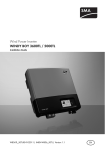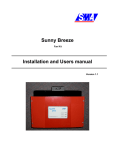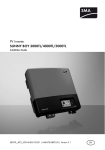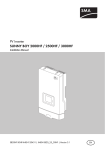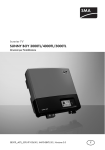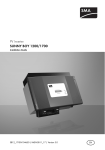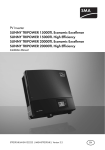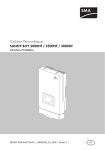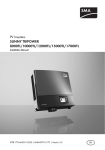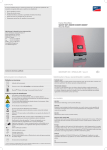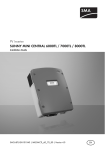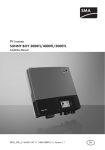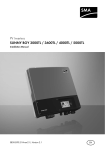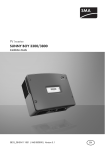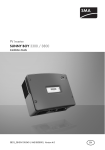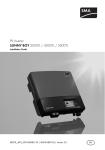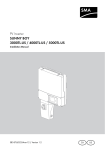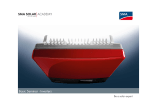Download SUNNY BOY 2000HF / 2500HF / 3000HF
Transcript
PV Inverter
SUNNY BOY 2000HF / 2500HF / 3000HF
Installation Guide
SB20_25_30HF-IEN102911 | IMEN-SB20_25_30HF | Version 1.1
EN
Device disturbance
Contact SMA Serviceline
Disturbance that can be remedied
on-site (see section10.3 )
Power curve of the past 16 feed-in hours or
past 16 days (switching the display is done by
tapping on the display)
• Fan might need cleaning
• Provide better ventilation for Sunny Boy
Power reduction due to excessive temperature
PV generator event number
Input voltage / input current
Grid event number
Output voltage / output voltage of
the phase as shown below
Sunny Boy event number
Grid relay
Bluetooth connection to other Sunny Boy
• Activating the background illumination
• Switching through the energy values of the past 16 feed-in hours to
the daily energy values of the past 16 days
• Switching through the line display
Tapping on the lower lid:
Text line for displaying an event
Total energy generated since the
Sunny Boy was installed
Daily energy
Current output
SMA Solar Technology AG
Table of Contents
Table of Contents
1
1.1
1.2
1.3
1.4
Notes on this Manual. . . . . . . . . . . . . . . . . . . . . . . . . . . . . .
Scope of Validity. . . . . . . . . . . . . . . . . . . . . . . . . . . . . . . . . . . . .
Target Group . . . . . . . . . . . . . . . . . . . . . . . . . . . . . . . . . . . . . . .
Additional Information . . . . . . . . . . . . . . . . . . . . . . . . . . . . . . . .
Symbols Used . . . . . . . . . . . . . . . . . . . . . . . . . . . . . . . . . . . . . . .
2
2.1
2.2
2.3
Safety . . . . . . . . . . . . . . . . . . . . . . . . . . . . . . . . . . . . . . . . . . 9
Appropriate Usage . . . . . . . . . . . . . . . . . . . . . . . . . . . . . . . . . . . 9
Safety Precautions. . . . . . . . . . . . . . . . . . . . . . . . . . . . . . . . . . . 11
Explanation of Symbols . . . . . . . . . . . . . . . . . . . . . . . . . . . . . . 12
2.3.1
Symbols on the Inverter. . . . . . . . . . . . . . . . . . . . . . . . . . . . . . . . . . . . . . . . . 12
2.3.2
Symbols on the Type Label . . . . . . . . . . . . . . . . . . . . . . . . . . . . . . . . . . . . . . 12
3
3.1
3.2
Unpacking. . . . . . . . . . . . . . . . . . . . . . . . . . . . . . . . . . . . . . 14
Scope of Delivery . . . . . . . . . . . . . . . . . . . . . . . . . . . . . . . . . . . 14
Identifying the Inverter . . . . . . . . . . . . . . . . . . . . . . . . . . . . . . . 15
4
4.1
4.2
4.3
Mounting the Device . . . . . . . . . . . . . . . . . . . . . . . . . . . . . 16
Safety . . . . . . . . . . . . . . . . . . . . . . . . . . . . . . . . . . . . . . . . . . . . 16
Selecting the Mounting Location. . . . . . . . . . . . . . . . . . . . . . . . 16
Mounting the Inverter with the Wall Mounting Bracket . . . . . . 18
5
5.1
5.2
5.3
The communication module (Quick Module). . . . . . . . . . 22
Safety . . . . . . . . . . . . . . . . . . . . . . . . . . . . . . . . . . . . . . . . . . . . 22
Inner View of the Quick Module. . . . . . . . . . . . . . . . . . . . . . . . 23
Configuration of the inverter via the Quick Module . . . . . . . . . 23
5.3.1
SMA Grid Guard Protected Country Data Sets . . . . . . . . . . . . . . . . . . . . . . 24
5.3.2
5.3.3
Checking the Country Standard . . . . . . . . . . . . . . . . . . . . . . . . . . . . . . . . . . 25
Opening the Quick Module . . . . . . . . . . . . . . . . . . . . . . . . . . . . . . . . . . . . . 28
5.3.4
Setting the Country Standard and Language using Rotary Switches . . . . . . 29
Installation Guide
SB20_25_30HF-IEN102911
7
7
7
7
8
3
Table of Contents
SMA Solar Technology AG
5.3.5
Communication via Bluetooth . . . . . . . . . . . . . . . . . . . . . . . . . . . . . . . . . . . 30
5.3.6
Closing the Quick Module . . . . . . . . . . . . . . . . . . . . . . . . . . . . . . . . . . . . . . 31
5.4
Mounting the Quick Module . . . . . . . . . . . . . . . . . . . . . . . . . . 32
5.4.1
Changes via rotary switches after installation of the Quick Module. . . . . . . 33
5.5
5.6
Dismantling the Quick Module . . . . . . . . . . . . . . . . . . . . . . . . . 36
Slot for SD card . . . . . . . . . . . . . . . . . . . . . . . . . . . . . . . . . . . . 37
6
6.1
6.2
Electrical Connection . . . . . . . . . . . . . . . . . . . . . . . . . . . . . 38
Overview of the Connection Area . . . . . . . . . . . . . . . . . . . . . . 38
Connection to the Public Grid (AC) . . . . . . . . . . . . . . . . . . . . . 39
6.2.1
Conditions for the AC Connection . . . . . . . . . . . . . . . . . . . . . . . . . . . . . . . . 39
6.2.2
Connecting the Inverter to the Public Grid (AC) . . . . . . . . . . . . . . . . . . . . . . 41
6.2.3
Connecting Additional Grounding . . . . . . . . . . . . . . . . . . . . . . . . . . . . . . . . 44
6.3
Connection of the PV Generator (DC) . . . . . . . . . . . . . . . . . . . 45
6.3.1
Conditions for the DC Connection . . . . . . . . . . . . . . . . . . . . . . . . . . . . . . . . 45
6.3.2
Assembling the DC Plug Connector . . . . . . . . . . . . . . . . . . . . . . . . . . . . . . . 46
6.3.3
Opening the DC Plug Connector . . . . . . . . . . . . . . . . . . . . . . . . . . . . . . . . . 48
6.3.4
Connecting the PV Generator (DC) . . . . . . . . . . . . . . . . . . . . . . . . . . . . . . . 49
7
7.1
7.2
7.3
Commissioning . . . . . . . . . . . . . . . . . . . . . . . . . . . . . . . . . . 52
Commissioning the Inverter . . . . . . . . . . . . . . . . . . . . . . . . . . . . 52
Display during Initialization . . . . . . . . . . . . . . . . . . . . . . . . . . . 53
Self-Test in accordance with ENEL Directive, Ed. 1.1
(Applies to Italy only) . . . . . . . . . . . . . . . . . . . . . . . . . . . . . . . . 54
7.3.1
Starting the Self-Test . . . . . . . . . . . . . . . . . . . . . . . . . . . . . . . . . . . . . . . . . . . 54
7.3.2
Test Sequence . . . . . . . . . . . . . . . . . . . . . . . . . . . . . . . . . . . . . . . . . . . . . . . . 55
7.3.3
Interruption of the Self-Test . . . . . . . . . . . . . . . . . . . . . . . . . . . . . . . . . . . . . . 58
7.3.4
Restarting the Self-Test. . . . . . . . . . . . . . . . . . . . . . . . . . . . . . . . . . . . . . . . . . 59
8
8.1
8.2
Disconnect the Inverter from Voltage Sources . . . . . . . . 60
Safety . . . . . . . . . . . . . . . . . . . . . . . . . . . . . . . . . . . . . . . . . . . . 60
Disconnect the Inverter from Voltage Sources . . . . . . . . . . . . . 60
4
SB20_25_30HF-IEN102911
Installation Guide
SMA Solar Technology AG
Table of Contents
9
9.1
Maintenance and Cleaning . . . . . . . . . . . . . . . . . . . . . . . . 63
Checking Heat Dissipation . . . . . . . . . . . . . . . . . . . . . . . . . . . . 63
9.1.1
Cleaning the fan . . . . . . . . . . . . . . . . . . . . . . . . . . . . . . . . . . . . . . . . . . . . . . 63
9.1.2
Checking the Fans. . . . . . . . . . . . . . . . . . . . . . . . . . . . . . . . . . . . . . . . . . . . . 66
10
10.1
10.2
10.3
Messages . . . . . . . . . . . . . . . . . . . . . . . . . . . . . . . . . . . . . . 67
The green LED is glowing or flashing . . . . . . . . . . . . . . . . . . . . 67
Event messages. . . . . . . . . . . . . . . . . . . . . . . . . . . . . . . . . . . . . 67
Error Messages. . . . . . . . . . . . . . . . . . . . . . . . . . . . . . . . . . . . . 68
11
11.1
11.2
Failure Search. . . . . . . . . . . . . . . . . . . . . . . . . . . . . . . . . . . 74
Checking the PV Generator for a Ground Fault . . . . . . . . . . . . 74
Checking the Functioning of the Varistors . . . . . . . . . . . . . . . . . 76
12
12.1
12.2
12.3
12.4
12.5
Decommissioning . . . . . . . . . . . . . . . . . . . . . . . . . . . . . . . . 80
Dismantling the Inverter. . . . . . . . . . . . . . . . . . . . . . . . . . . . . . . 80
Replacing the Enclosure Lid . . . . . . . . . . . . . . . . . . . . . . . . . . . 81
Packing the Inverter. . . . . . . . . . . . . . . . . . . . . . . . . . . . . . . . . . 82
Storing the Inverter . . . . . . . . . . . . . . . . . . . . . . . . . . . . . . . . . . 82
Disposing of the Inverter . . . . . . . . . . . . . . . . . . . . . . . . . . . . . . 82
13
13.1
13.2
13.3
Technical Data . . . . . . . . . . . . . . . . . . . . . . . . . . . . . . . . . . 83
Sunny Boy 2000HF . . . . . . . . . . . . . . . . . . . . . . . . . . . . . . . . . 83
Sunny Boy 2500HF . . . . . . . . . . . . . . . . . . . . . . . . . . . . . . . . . 86
Sunny Boy 3000HF . . . . . . . . . . . . . . . . . . . . . . . . . . . . . . . . . 89
14
Accessories . . . . . . . . . . . . . . . . . . . . . . . . . . . . . . . . . . . . . 92
15
Contact . . . . . . . . . . . . . . . . . . . . . . . . . . . . . . . . . . . . . . . . 93
Installation Guide
SB20_25_30HF-IEN102911
5
Table of Contents
6
SB20_25_30HF-IEN102911
SMA Solar Technology AG
Installation Guide
SMA Solar Technology AG
Notes on this Manual
1 Notes on this Manual
1.1 Scope of Validity
This manual describes the assembly, installation, commissioning and maintenance of the following
SMA inverters:
• Sunny Boy 2000HF (SB 2000HF-30)
• Sunny Boy 2500HF (SB 2500HF-30)
• Sunny Boy 3000HF (SB 3000HF-30)
Store this manual where it can be accessed at all times.
1.2 Target Group
This manual is for qualified personnel. The tasks described in this manual must only be performed by
qualified personnel.
1.3 Additional Information
You will find further information on special topics such as designing a line circuit breaker or the
description of the parameters and measurement readings in the download area at www.SMA.de/en.
Refer to the user manual for detailed information on operating the inverter.
Installation Guide
SB20_25_30HF-IEN102911
7
Notes on this Manual
SMA Solar Technology AG
1.4 Symbols Used
The following types of safety precautions and general information are used in this guide:
DANGER!
DANGER indicates a hazardous situation which, if not avoided, will result in death or
serious injury.
WARNING!
"WARNING" indicates a hazardous situation which, if not avoided, could result in death
or serious injury.
CAUTION!
"CAUTION" indicates a hazardous situation which, if not avoided, could result in minor or
moderate injury.
NOTICE!
"NOTICE" indicates a situation that can result in property damage if not avoided.
Information
Information provides tips that are valuable for the optimal installation and operation of
your product.
☑
8
This symbol indicates the result of an action.
SB20_25_30HF-IEN102911
Installation Guide
SMA Solar Technology AG
Safety
2 Safety
2.1 Appropriate Usage
The Sunny Boy is a PV inverter which converts the direct current of a PV generator into alternating
current and feeds this into the public grid.
Principle of a PV plant with this Sunny Boy
The Sunny Boy must only be operated with PV generators (modules and cabling) of protection class
II. Do not connect any sources of energy other than PV modules to the Sunny Boy.
When designing the PV system, ensure that the values comply with the permitted operating range of all
components at all times. The free design program "Sunny Design" (www.SMA.de/en/SunnyDesign)
will assist you. The manufacturer of the PV modules must have approved the modules for use with this
Sunny Boy device. You must also ensure that all measures recommended by the module manufacturer
for long-term maintenance of the module properties are taken (see also Technical Information "Module
Technology", in the download area of www.SMA.de/en).
Do not use the Sunny Boy for purposes other than those described here. Alternative uses,
modifications to the Sunny Boy or the installation of components not expressly recommended or sold
by SMA Solar Technology AG void the warranty claims and operation permission.
Installation Guide
SB20_25_30HF-IEN102911
9
Safety
SMA Solar Technology AG
Certified Countries
The Sunny Boy 2000HF / 2500HF / 3000HF (with according configuration) fulfill the requirements
specified in the following standards and directives (dated: 05/2010):
• AS4777 (2005) *
• CER/06/190 (10.2006) *
• C10/11 (05.2009)
• Enel-GUIDA Ed. 1.1 *
• EN 50438:2008 **
• G83/1-1:2008 *
• IEC61727 *
• PPC (06.2006) *
• PPDS: 2009 *
• RD 1663/2000 *
• RD 661/2007 *
• SI4777 *
• VDE 0126-1-1 (02.2006)
* On request
** does not apply to national standard deviations of EN 50438
SMA Solar Technology AG can preset special grid parameters for other countries / installation
locations according to customer request, after evaluation by SMA Solar Technology AG.
You can make later modifications yourself by changing software parameters with respective
communication products (e.g. Sunny Data Control or Sunny Explorer). To change grid-relevant
parameters, you need a personal access code - the so-called SMA Grid Guard Code. The
application form for the personal access code is located in the download area at www.SMA.de/en,
in the "Certificate" category for each inverter.
10
SB20_25_30HF-IEN102911
Installation Guide
SMA Solar Technology AG
Safety
2.2 Safety Precautions
DANGER!
Danger to life due to high voltages in the inverter.
• All work on the inverter must be carried out by qualified personnel only.
• The appliance is not to be used by children or persons with reduced physical, sensory
or mental capabilities, or lack of experience and knowledge, unless they have been
given supervision or instruction.
• Children should be supervised to ensure that they do not play with the appliance.
CAUTION!
Danger of burn injuries due to hot enclosure parts.
The enclosure can become hot during operation.
• Do not touch the inverter's enclosure during operation.
CAUTION!
Possible damage to health as a result of the effects of radiation!
• Do not stay closer than 20 cm to the inverter for any length of time.
Grounding the PV generator
Comply with the local requirements for grounding the modules and the PV generator.
SMA Solar Technology AG recommends connecting the generator frame and other
electricity-conducting surfaces such that there is continuous conduction and to connect them
to the ground in order to reach maximum protection for property and persons.
Installation Guide
SB20_25_30HF-IEN102911
11
Safety
SMA Solar Technology AG
2.3 Explanation of Symbols
This section contains an explanation of all symbols found on the inverter and type label.
2.3.1 Symbols on the Inverter
Symbol
Explanation
Operation Display.
Indicates the operation condition of the inverter.
An error has occurred.
Read section 11 ”Failure Search” (page 74) to remedy the error.
Bluetooth ® Wireless Technology.
Shows the status of Bluetooth Communication.
Electronic Solar Switch (ESS) DC load disconnection unit
•
When the Electronic Solar Switch is plugged in, the DC circuit is
closed.
•
To interrupt the DC circuit and disconnect the inverter securely
under load, you have to first pull out the Electronic Solar Switch
and then remove all DC plug connectors , as described in section
8 ”Disconnect the Inverter from Voltage Sources” (page 60).
2.3.2 Symbols on the Type Label
Symbol
Explanation
Beware of dangerous electrical voltage.
The inverter operates at high voltages. All work on the inverter must be
carried out by qualified personnel only.
Beware of hot surface.
The inverter can become hot during operation. Avoid contact during
operation.
Observe all documentation that accompanies the inverter.
The inverter must not be disposed of together with the household waste. For
more information on disposal, see section 12.5 ”Disposing of the Inverter”
(page 82).
12
SB20_25_30HF-IEN102911
Installation Guide
SMA Solar Technology AG
Symbol
Safety
Explanation
CE mark.
The inverter complies with the requirements of the applicable EC
guidelines.
The inverter has a transformer.
Direct Current (DC)
Alternating Current (AC)
Protection rating IP65.
The inverter is protected against penetration by dust particles and water
jets from any angle.
RAL quality mark for solar products.
The inverter complies with the requirements of the German Institute for
Quality Assurance and Labeling.
Device class label.
The inverter is equipped with a wireless component that complies with the
harmonized standards.
Certified safety
The inverter complies with the requirements of the Equipment and Product
Safety Act in Europe.
Australian mark of conformity
The inverter complies with the requirements of the applicable guidelines.
Korean mark of conformity
The inverter complies with the requirements of the applicable guidelines.
Installation Guide
SB20_25_30HF-IEN102911
13
Unpacking
SMA Solar Technology AG
3 Unpacking
3.1 Scope of Delivery
Check the delivery for completeness and any visible external damage. Contact your dealer if anything
is damaged or missing.
Object
A
B
C
D
E
F
G
H
I
K
L
Quantity
1
1
1
1
1
1
1
1
4
4
1
Description
Sunny Boy
Wall mounting bracket
Document set
Supplementary sheet with inverter factory settings
Installation Guide
User Manual
DC load disconnection unit Electronic Solar Switch (ESS handle with fan)
Communication module (Quick Module)
Sealing plugs for DC plug connectors
DC connectors (2 x positive / 2 x negative)
AC coupling socket: socket element, protective cap for AC socket on
inverter, threaded sleeve, sealing ring, clamping nut.
Connection screw for anti-lifting lock
M
1
14
SB20_25_30HF-IEN102911
Installation Guide
SMA Solar Technology AG
Unpacking
3.2 Identifying the Inverter
You can identify the inverter using the type label. The type label is on the right side of the enclosure.
The serial number (Serial No.) and the type (Type / Model) of the inverter, as well as device-specific
characteristics, are specified on the type label.
Installation Guide
SB20_25_30HF-IEN102911
15
Mounting the Device
SMA Solar Technology AG
4 Mounting the Device
4.1 Safety
DANGER!
Danger to life due to fire or explosion.
Despite careful construction, electrical devices can cause fires.
• Do not mount the inverter on flammable construction materials.
• Do not mount the inverter in areas where highly flammable materials are stored.
• Do not mount the inverter in areas with a risk of explosion.
CAUTION!
Danger of burn injuries due to hot enclosure parts.
• Mount the inverter in such a way that it cannot be touched inadvertently during
operation.
CAUTION!
Risk of injury due to the heavy weight of the inverter.
• Take the inverter's weight of approx. 17 kg into account for mounting.
4.2 Selecting the Mounting Location
Consider the following points when selecting where to install:
• The mounting method and location must be suitable for the inverter's weight and dimensions
(see section 13 ”Technical Data” (page 83)).
• Mount on a solid surface.
• The mounting location must at all times be clear and have safe access without the use of
additional aids such as scaffolding or lifting platforms. Any possible service actions are
otherwise limited.
16
SB20_25_30HF-IEN102911
Installation Guide
SMA Solar Technology AG
Mounting the Device
• Vertical installation or tilted backward by max. 30°.
• The connection area must point downward.
• Never mount the device with a forward tilt.
• Never install the device with a sideways tilt.
• Do not mount horizontally.
• Mount at eye level to allow operating status to be read at all times.
• The ambient temperature should be below +40 °C to ensure optimal operation.
• Do not expose the inverter to direct sunlight to avoid a power reduction due to excessive
heating.
• In living areas, do not mount the unit on plasterboard walls or similar in order to avoid audible
vibrations. The inverter can make noises when in use, which may be perceived as a nuisance in
a living area.
• Observe the minimum clearances to walls, other
inverters or objects as shown in the diagram in
order to ensure sufficient heat dissipation and
sufficient space for the removal of the Electronic
Solar Switch.
Multiple inverters installed in areas with high ambient temperatures
If necessary, increase the clearances between the individual inverters. In addition, make
sure there is enough ventilation to ensure sufficient cooling of the inverters.
Installation Guide
SB20_25_30HF-IEN102911
17
Mounting the Device
SMA Solar Technology AG
4.3 Mounting the Inverter with the Wall Mounting Bracket
1. Use the wall mounting bracket as a drilling template and mark the positions of the drill holes.
Number of drill holes used
• When mounting onto the wall, use at least 1 upper hole right and left and when
necessary the lowest hole in the middle.
• Use the middle upper and lower holes when mounting to a pillar.
18
SB20_25_30HF-IEN102911
Installation Guide
SMA Solar Technology AG
Mounting the Device
2. Attach the wall mounting bracket to the wall using
appropriate screws (diameter min. 6 mm,
max. 8 mm) and washers (outer diameter
min. 12 mm, max. 24 mm).
3. Transport the inverter using the handles on the
sides.
4. Hang the inverter with its mounting slots from above
in the wall mounting.
Installation Guide
SB20_25_30HF-IEN102911
19
Mounting the Device
SMA Solar Technology AG
5. Check to ensure that the inverter is correctly seated.
6. Use the connection screws (see position "M" in the
scope of delivery on page 14) provided to fix the
inverter and prevent it from being lifted out of place.
☑ The inverter is now securely mounted to the wall.
20
SB20_25_30HF-IEN102911
Installation Guide
SMA Solar Technology AG
Mounting the Device
Optional Theft Protection
To protect the inverter from theft, you can lock it to the
wall mounting bracket with a padlock.
The lock must meet the following requirements:
• Size:
A: maximum 6 mm diameter
B: 21 – 35 mm
C: 20 – 33 mm
D: 40 – 60 mm
E: 13 – 21 mm
• Stainless
• Hardened shackle
• Secured lock cylinder
Storage of the key
Store the key carefully for possible service purposes.
Installation Guide
SB20_25_30HF-IEN102911
21
The communication module (Quick Module)
SMA Solar Technology AG
5 The communication module (Quick Module)
The inverter is fitted with a communication module (Quick Module) as standard. In the Quick Module
there is a slot for an SD card and 3 rotary switches with the following functions:
• Rotary switches A and B are for setting the country of installation and the display language (see
section 5.3 ”Configuration of the inverter via the Quick Module” (page 23)).
• Rotary switch C is for the allocation of the NetID for communication via Bluetooth
(see section 5.3.5 ”Communication via Bluetooth” (page 30)).
Quick Module with RS485 interface and multi-function relay
(RS485- Quick Module)
You can purchase a Quick Module with an RS485 interface and a multi-function relay
(RS485-Quick Module) from SMA Solar Technology AG or your dealer
(see section 14 ”Accessories” (page 92)). You will find detailed descriptions of the
functions in the respective manual.
Configuration of the Quick Module
You can configure the Quick Module before you connect it to the inverter.
5.1 Safety
DANGER!
Risk of lethal electric shock.
If you have already connected the Quick Module to the inverter, then you have to
disconnect the inverter on the AC and DC sides before you accept the settings on the
Quick Module.
• Disconnect the inverter as described in section 8 ”Disconnect the Inverter from
Voltage Sources” (page 60).
22
SB20_25_30HF-IEN102911
Installation Guide
SMA Solar Technology AG
The communication module (Quick Module)
5.2 Inner View of the Quick Module
Object
A
B
C
D
E
Description
Rotary switch for setting the country standard (switch A)
Rotary switch for setting the display language (switch B)
Rotary switch for the configuration of Bluetooth communication (switch C)
Slot for SD card
Jumper slot for setting the language to English (E)
5.3 Configuration of the inverter via the Quick Module
The inverter can be configured for various countries. This is carried out via the two rotary switches in
the Quick Module (switch A and switch B) before commissioning or via the configuration of the
"CntrySet" or "Set country standard" parameter via an external communication device with Bluetooth
interface once you have commissioned the inverter.
Alternative configuration with RS485
If your inverter is fitted with a Quick Module with RS485 interface, then your inverter can
also communicate via RS485.
Installation Guide
SB20_25_30HF-IEN102911
23
The communication module (Quick Module)
SMA Solar Technology AG
5.3.1 SMA Grid Guard Protected Country Data Sets
In some countries, the local power supply line requirements demand a mechanism which prevents the
parameters for grid feeding from being able to be changed. Some country data sets are therefore
protected and can only be unlocked with a personal access code, the so-called
SMA Grid Guard code.
SMA Grid Guard protected country data sets are automatically blocked for 10 feed-in hours after
commissioning, or after the last alteration. If the country data set is changed via the rotary switch after
these 10 feed-in hours, the inverter will not accept the changes and displays the error message
"Grid parameter locked". If,however, a later change to the country data set only relates to a change
of the display language, this change is immediately taken on.
It is also possible via a communication device to configure ("CntrySet" or "Set country standard") as
well as to manually block or unblock country data sets. To lock, you have to set the so-called
SMA Grid Guard code to "54321". This will automatically appear as an input window when
changing the first grid-relevant parameter. The data set can only be unlocked by entering a personal,
10-digit SMA Grid Guard code which is valid for a maximum of 10 grid-feed hours. The application
form for the personal access code is located in the download area at www.SMA.de/en, in the
"Certificate" category for each inverter. The language is configurable without a password
independent of the country data set.
Changing of parameters in SMA Grid Guard protected country data sets
If the parameters within protected country data sets are changed, these are no longer
protected and instead of the standard, "ADJ" or "Special setting" is displayed. In this case,
the parameters are not changed automatically after 10 grid-feed hours, but have to be
manually locked. To manually lock the parameters, set the SMA Grid Guard code to
"54321".
Detailed information on parameter settings
Detailed information on how to proceed with respect to setting and changing parameters
is available in the respective user manual for your software.
The last change (executed via rotary switch or communication device) is always verified and activated
if applicable. This means that you can not always read off the actual country setting from the switch
position.
24
SB20_25_30HF-IEN102911
Installation Guide
SMA Solar Technology AG
The communication module (Quick Module)
5.3.2 Checking the Country Standard
The switch position 0 / 0 indicates the delivered state. If you have ordered the inverter with specific
country settings, these will have already been preset in the factory via a communication device. In this
case, you will not be able to recognize the setting by the switch position. These settings will be
overwritten by changes to the rotary switch or via a communication device and can not simply be reconstructed. For devices ordered without any specified country of installation, the standard setting is
"VDE0126-1-1" and the language is "german".
Changes will be immediately accepted after switching the line circuit breaker on. If an unprogrammed
switch setting is selected, the inverter issues an error message.
Check whether the inverter is set to the installation country.
Before commissioning:
• Check that the country setting of the inverter is correct using the supplement provided and
comparing this to the the factory settings of the inverter.
After commissioning:
• Check that the country standard is correct on the basis of the display message during
(re‑)commissioning (see section 7.2 ”Display during Initialization” (page 53)).
or
• Check that the country standard is correct on the basis of the "SMA grid guard" measuring
channel via a communication device.
Display language
Once you have set the country standard, you can always set the display language later
using rotary switch B. However, you have to then set the rotary switch A to "0" in order to
keep the country data set.
The operating parameters define which setting is hidden behind which parameter set. The parameters
can be read out using a communication device. A detailed description of the parameters and
measurement values for the inverter is available in the download area at www.SMA.de/en in the
category "Technical Description" of the respective inverter.
(A)
(B)
Country data set
Display language
0
0
Delivery state
Delivery state
0
1
Retained
English
0
2
Retained
German
0
3
Retained
French
0
4
Retained
Spanish
Installation Guide
Grid guard
protection
Dependent on
parameter set
Dependent on
parameter set
Dependent on
parameter set
Dependent on
parameter set
Dependent on
parameter set
Country
Dependent on
parameter set
Dependent on
parameter set
Dependent on
parameter set
Dependent on
parameter set
Dependent on
parameter set
SB20_25_30HF-IEN102911
25
The communication module (Quick Module)
SMA Solar Technology AG
(A)
(B)
Country data set
Display language
0
5
Retained
Italian
0
6
Retained
Not programmed**
0
7
Retained
Not programmed**
1
0
VDE0126-1-1
German
Grid guard
protection
Dependent on
parameter set
Dependent on
parameter set
Dependent on
parameter set
Yes
1
8
VDE0126-1-1
French
Yes
1
2
2
3
3
4
4
4
4
5
5
6
6
6
6
6
6
6
7
7
7
7
7
7
8
8
8
9
0
8
0
8
0
1
8
9
1
8
0
1
2
3
4
5
6
0
1
2
8
9
A
0
1
2
VDE0126-1-1B a)
VDE0126-1-1
AS4777.3
Enel-GUIDA
Enel-GUIDA
RD1663-A
RD1663/661-A
PPC
PPC
KEMCO 501/2008
G83/1-1
EN 50438
EN 50438
EN 50438
EN 50438
EN 50438
EN 50438
EN 50438
EN50438-CZ
EN50438-CZ
EN50438-CZ
C10/11
C10/11
C10/11
UL1741/208 ***
UL1741/208 ***
UL1741/208 ***
French
Italian
English
Italian
German
Spanish
Spanish
Not programmed**
English
English
English
German
English
French
Italian
Spanish
Not programmed**
Not programmed**
Not programmed**
English
German
French
English
German
English
Spanish
French
Yes
Yes
No
No
No
Yes
Yes
No
No
No
No
Yes
Yes
Yes
Yes
Yes
Yes
Yes
Yes
Yes
Yes
Yes
Yes
Yes
No
No
No
26
SB20_25_30HF-IEN102911
Country
Dependent on
parameter set
Dependent on
parameter set
Dependent on
parameter set
Germany,
Switzerland
Switzerland,
France
France
Switzerland
Australia
Italy
Italy
Spain
Spain
Greece
Greece
South Korea
England
various EU
countries
Czech Republic
Czech Republic
Czech Republic
Belgium
Belgium
Belgium
USA
USA
USA
Installation Guide
SMA Solar Technology AG
The communication module (Quick Module)
(A)
(B)
Country data set
Display language
8
8
8
9
9
9
D
D
D
D
D
D
D
E
E
E
E
E
E
E
8
9
A
8
9
A
0
1
2
3
4
5
6
0
1
2
3
4
5
6
UL1741/240 ***
UL1741/240 ***
UL1741/240 ***
UL1741/auto ***
UL1741/auto ***
UL1741/auto ***
Off-Grid 60Hz
Off-Grid 60Hz
Off-Grid 60Hz
Off-Grid 60Hz
Off-Grid 60Hz
Off-Grid 60Hz
Off-Grid 60Hz
Off-Grid 50Hz
Off-Grid 50Hz
Off-Grid 50Hz
Off-Grid 50Hz
Off-Grid 50Hz
Off-Grid 50Hz
Off-Grid 50Hz
English
Spanish
French
English
Spanish
French
English
German
French
Spanish
Italian
Not programmed**
Not programmed**
English
German
French
Spanish
Italian
Not programmed**
Not programmed**
Grid guard
protection
No
No
No
No
No
No
No
No
No
No
No
No
No
No
No
No
No
No
No
No
a)
Special setting: Bluetooth transmission power reduced (in accordance with French standards)
*)
In planning
**)
Currently not programmed. The previously configured display language remains set.
***)
This country standard must only be set for Sunny Boy 2000HF-US / 2500HF-US / 3000HF-US.
Country
USA
USA
USA
USA
USA
USA
Flexible
Flexible
Flexible
Flexible
Flexible
Flexible
Flexible
Flexible
Flexible
Flexible
Flexible
Flexible
Flexible
Flexible
Should the inverter not be set to the installation country, you have several options to configure the
country standard required.
• Setting via 2 rotary switches in Quick Module, as described in section 5.3.4 ”Setting the
Country Standard and Language using Rotary Switches” (page 29).
• Alternatively you can adjust the setting via the "CntrySet" or "Set country standard" parameters
with a communication device (e.g. Sunny Data Control or Sunny Explorer), once you have
commissioned the inverter.
• If you require adjusted parameter settings for your installation location, you can change these
with the help of a communication device.
Installation Guide
SB20_25_30HF-IEN102911
27
The communication module (Quick Module)
SMA Solar Technology AG
5.3.3 Opening the Quick Module
1. If the Quick Module is already connected to the inverter, proceed as follows:
– Disconnect the inverter on the AC and DC sides as described in section 8 ”Disconnect the
Inverter from Voltage Sources” (page 60).
– Pull the Quick Module out to the first stopper.
2. Flip the lower flap of the Quick Module up.
3. Open the lid of the Quick Module, until it locks in
place.
☑ The Quick Module is opened. You can now set the installation country and the language via
the rotary switches as described in the following section.
28
SB20_25_30HF-IEN102911
Installation Guide
SMA Solar Technology AG
The communication module (Quick Module)
5.3.4 Setting the Country Standard and Language using
Rotary Switches
1. Open the Quick Module, as described in section 5.3.3 ”Opening the Quick Module”
(page 28).
2. Set the arrows on both left rotary switches (A and
B) using a screw driver to the desired positions (see
table in section 5.3.2 ”Checking the Country
Standard” (page 25)). The width of the screwdriver
should be 2.5 mm.
Jumper for English language
You can also set the language to English by
means of a jumper (e.g. for service purposes).
• To do this, plug the jumper onto both left
pins as shown on the right.
☑ The country standard and the language are set.
Installation Guide
SB20_25_30HF-IEN102911
29
The communication module (Quick Module)
SMA Solar Technology AG
5.3.5 Communication via Bluetooth
Communication via Bluetooth with a communication device is activated as standard. Networking via
Bluetooth with other inverters is deactivated ex works.
The following configuration settings are possible via a rotary switch (switch C):
Switch position (NetID)
0
1
2…F
Setting
Off
Communication via Bluetooth with communication device possible, no
networking with other inverters (factory setting)
Networking with other inverters and/or communication devices
In order to restrict communication via Bluetooth between the inverters of your system and those of
neighboring systems, you can assign an individual NetID to the inverters of your system (switch
position 2 … F). This, however, is only necessary if neighboring systems are within a radius of 500 m.
So that all inverters in your PV system are detected by your communication device, all inverters must
have the same NetID.
Procedure
1. Open the Quick Module, as described in section 5.3.3 ”Opening the Quick Module”
(page 28).
2. Set the arrow on the rotary switch (C) to the
required position using a screwdriver. The width of
the screwdriver should be 2.5 mm.
Acceptance of settings
The Bluetooth settings will first be accepted upon commissioning.
30
SB20_25_30HF-IEN102911
Installation Guide
SMA Solar Technology AG
The communication module (Quick Module)
5.3.6 Closing the Quick Module
1. Close the lid of the Quick Module and flip the flap
down again until it locks into place.
☑ You can now connect the Quick Module to the inverter, as described in the following section.
Installation Guide
SB20_25_30HF-IEN102911
31
The communication module (Quick Module)
SMA Solar Technology AG
5.4 Mounting the Quick Module
NOTICE!
Damage to the Quick Module due to improper installation in the inverter.
The Quick Module could be damaged when incorrectly installed in the inverter.
• Check the Quick Module for visible external damage before installation.
• Carefully install the Quick Module, as described in the following section.
1. Disconnect the inverter on the AC and DC sides as described in section 8 ”Disconnect the
Inverter from Voltage Sources” (page 60).
2. Put the Quick Module into the designated holes on
the bracket.
3. Push the Quick Module upwards in the guide slot
until it clicks into place.
4. Check that the Quick Module is correctly seated.
The loops of the Quick Module and the bracket
must be positioned flush on top of each other.
☑ The Quick Module is mounted.
32
SB20_25_30HF-IEN102911
Installation Guide
SMA Solar Technology AG
The communication module (Quick Module)
5.4.1 Changes via rotary switches after installation of the
Quick Module
If you have already connected the Quick Module to the inverter and would like for example to
configure the installation country or the display language via the rotary switches, then proceed as
follows:
1. Disconnect the inverter on the AC and DC sides as described in section 8 ”Disconnect the
Inverter from Voltage Sources” (page 60).
2. Pull the Quick Module out to the first stopper.
3. Flip the flap up and pen the lid until it locks in place.
4. See section 5.3.4 ”Setting the Country Standard and Language using Rotary Switches”
(page 29) for setting the installation country and the display language.
5. See section 5.3.5 ”Communication via Bluetooth” (page 30) for assigning the NetID via
Bluetooth.
6. Close the lid of the Quick Module and flip the flap
down again until it locks into place.
Installation Guide
SB20_25_30HF-IEN102911
33
The communication module (Quick Module)
SMA Solar Technology AG
7. Push the Quick Module upwards in the guide slot
until it clicks into place.
8. Check that the Quick Module is correctly seated.
The loops of the Quick Module and the bracket
must be positioned flush on top of each other.
9. Connect the AC plug.
34
SB20_25_30HF-IEN102911
Installation Guide
SMA Solar Technology AG
The communication module (Quick Module)
10. Check the DC connector for correct polarity and
connect it.
11. Connect the Electronic Solar Switch.
NOTICE!
Damage to Electronic Solar Switch.
If it is not correctly connected, the Electronic Solar Switch can be damaged.
• Connect the handle firmly on to the socket of the Electronic Solar Switch.
• The holder must close flush with the enclosure.
12. If a multi-function relay is connected, switch on the multi-function relay power supply.
13. Switch on the line circuit breaker.
☑ The changes have been set.
Installation Guide
SB20_25_30HF-IEN102911
35
The communication module (Quick Module)
SMA Solar Technology AG
5.5 Dismantling the Quick Module
1. Disconnect the inverter on the AC and DC sides as described in section 8 ”Disconnect the
Inverter from Voltage Sources” (page 60).
2. Pull the Quick Module out over the first stopper to
the last stopper.
3. Lift the Quick Module upwards until the guide lugs
pass through the openings of the bracket.
4. Carefully take the Quick Module out of the bracket.
☑ The Quick Module is disassembled.
36
SB20_25_30HF-IEN102911
Installation Guide
SMA Solar Technology AG
The communication module (Quick Module)
5.6 Slot for SD card
The Quick Module is fitted with a slot for an SD card. The
slot is to be found on the outside of the Quick Module (A).
There are a number of cases which require an SD card to be read in, such as:
• Under consultation with the SMA Serviceline, a firmware update is necessary.
SMA Solar Technology AG will send you a file with the firmware update per e-mail.
You will find the description of the Firmware update in the download area at www.SMA.de/en.
Properties of the SD Card
Use an SD card that is FAT16 or FAT32 formatted and has a maximum storage capacity
of 2 GB.
Use the SD card exclusively for this inverter. Do not save any multimedia files or other
unsuitable files on the SD card.
Installation Guide
SB20_25_30HF-IEN102911
37
Electrical Connection
SMA Solar Technology AG
6 Electrical Connection
6.1 Overview of the Connection Area
The following figure shows the assignment of the individual connection areas on the bottom of the
inverter.
Object
A
B
C
D
E
F
38
Description
DC connectors ( + ) for connecting the PV strings
DC connectors ( − ) for connecting the PV strings
Slot for the communication module (Quick Module / RS485 Quick Module)
Slot for optional grounding with protective cap
Socket for the AC connection plug
Socket for the connection of the Electronic Solar Switch (ESS)
SB20_25_30HF-IEN102911
Installation Guide
SMA Solar Technology AG
Electrical Connection
6.2 Connection to the Public Grid (AC)
6.2.1 Conditions for the AC Connection
Connection requirements of the utility operator
Always observe the connection requirements of your utility operator.
Cable Sizing
The grid impedance of the AC cable must not exceed 1 Ω .
The conductor cross-section should be dimensioned such that cable losses do not exceed 1 % at
nominal power. Use "Sunny Design" (www.SMA.de/en/SunnyDesign) for this.
The maximum cable lengths relative to the conductor cross-section are shown in the following table.
Do not exceed the maximum cable length.
Conductor
cross-section
SB 2000HF-30
18 m
29 m
2.5 mm²
4.0 mm²
Max. cable length
SB 2500HF-30
14.5 m
23 m
SB 3000HF-30
12 m
19 m
The conductor cross-sectional area required in individual cases depends on the following factors
among others:
• Ambient temperature,
• Routing method,
• Conduction losses,
• valid installation requirements of the respective country (installation location).
Cable requirements
Position
A
B
C
Installation Guide
Description
External diameter
Conductor cross-section
Strip insulation
Value
6 mm … 14 mm
2.5 mm² … 4 mm²
8 mm
SB20_25_30HF-IEN102911
39
Electrical Connection
SMA Solar Technology AG
Load Disconnection Unit
You must install a separate line circuit breaker for each inverter in order to ensure that the inverter
can be securely disconnected under load. The maximum permissible rating is located in
section 13 ”Technical Data” (page 83).
Detailed information and examples for the rating of a line circuit breaker can be found in the Technical
Information "Line Circuit Breaker" in the SMA Solar Technology AG download area at
www.SMA.de/en.
DANGER!
Danger to life due to fire.
When more than one inverter is connected to the same line circuit breaker, the protective
function of the line circuit breaker is no longer guaranteed. It can result in a cable fire or
the destruction of the inverter.
• Never connect several inverters to the same line circuit breaker.
• Comply with the maximum permissible fuse protection of the inverter when selecting
the line circuit breaker.
DANGER!
Danger to life due to fire.
When a generator (inverter) and a consumer are connected to the same line circuit
breaker, the protective function of the line circuit breaker is no longer guaranteed. The
current from the inverter and the grid can accumulate to overcurrent, which is not detected
by the line circuit breaker.
• Never connect consumers between the
inverter and the line circuit breaker
without protection.
• Always protect consumers separately.
NOTICE!
Damage to the inverter by using screw type fuse elements as a load
disconnection unit!
A screw type fuse element, e.g. D system (Diazed) or D0 system (Neozed) is not a load
disconnection unit, and thus must not be used as a load disconnection unit. A screw type
fuse element is only used as cable protection.
When disconnecting under load using a screw type fuse element, the inverter can be
damaged.
• Use only a load disconnection switch or a line circuit breaker as a load disconnecting
unit.
40
SB20_25_30HF-IEN102911
Installation Guide
SMA Solar Technology AG
Electrical Connection
6.2.2 Connecting the Inverter to the Public Grid (AC)
Overview of the AC Coupling Socket
Object
A
B
C
D
E
Description
Protective cap for AC socket on inverter
Socket element
Threaded sleeve with sealing ring for cable diameters from 10 mm to 14 mm
Sealing ring for cable diameters of 6 mm to 10 mm
Clamping nut
Connecting the Inverter to the Public Grid (AC)
1. Check the correct country setting of the inverter using the supplement provided against the
factory settings.
If the inverter is not set to the desired country standard, then adjust the country standard using
the rotary switches in the Quick Module as described in section 5.3.4 ”Setting the Country
Standard and Language using Rotary Switches” (page 29).
2. Check the grid voltage and compare it with the permissible voltage range (VAC)
(see section 13 ”Technical Data” (page 83)).
3. Disconnect the line circuit breaker and secure against re-connection.
4. If necessary, exchange the sealing ring of the threaded sleeve with the sealing ring provided.
– Pull the sealing ring out of the threaded sleeve.
– Insert the smaller sealing ring.
5. Thread the clamping nut (E) over the AC cable.
Installation Guide
SB20_25_30HF-IEN102911
41
Electrical Connection
SMA Solar Technology AG
6. Thread the threaded sleeve (C) over the AC cable.
7. Bend the AC line if needed for the connection. The
bend radius must be at least four times the cable
diameter.
8. Shorten the cable.
9. Shorten phase L and neutral conductor N 4 mm to 5 mm.
The PE protective conductor must be longer than the connection wires of N and L.
10. Insert the grounding conductor PE (green-yellow) in
the screw terminal with the earth sign on the socket
element and tighten the screw.
11. Insert the neutral conductor N (blue) in the screw
terminal N on the socket element and tighten the
screw.
12. Insert phase L (brown or black) into the screw
terminal L on the socket element and tighten the
screw.
13. Make sure the wires are securely connected.
14. Push the threaded sleeve (C) onto the socket element (B) until it audibly snaps into place.
42
SB20_25_30HF-IEN102911
Installation Guide
SMA Solar Technology AG
Electrical Connection
15. Screw the clamping nut (E) tightly onto the threaded sleeve (C). The clamping nut serves to seal
and relieve strain.
☑ The AC connection socket has been screwed together.
16. If the AC connection socket is not immediately connected to the inverter, close the AC socket on
the inverter with the protective cap provided.
17. Insert the AC connection socket into the AC socket
on the inverter audibly snaps into place.
Remove the protective cap beforehand as required.
☑ The AC cable is now connected to the inverter.
DANGER!
Danger to life due to high voltages in the inverter.
• Do not switch on the line circuit breaker until the PV generator has been connected
and the inverter is securely closed.
Installation Guide
SB20_25_30HF-IEN102911
43
Electrical Connection
SMA Solar Technology AG
6.2.3 Connecting Additional Grounding
If a second protective conductor connection, additional grounding or a potential equalization is
required in the country of installation, you can also ground the inverter on the enclosure (see
illustration).
44
SB20_25_30HF-IEN102911
Installation Guide
SMA Solar Technology AG
Electrical Connection
6.3 Connection of the PV Generator (DC)
6.3.1 Conditions for the DC Connection
Use of Adaptors
Adaptors (branch connectors) must not be visible or freely accessible in the immediate
surroundings of the inverter.
• The DC current flow must not be interrupted via adaptors.
• Observe the procedure for disconnecting the inverter as described in
section 8 ”Disconnect the Inverter from Voltage Sources” (page 60).
• Requirements for the PV modules of the connected strings:
– Same type
– Same number
– Identical alignment
– Identical tilt
• The connecting cables from the PV modules must be fitted with plug connectors. You will find
the necessary DC plug connector for DC connection in the delivery.
• The following limit values at the DC input of the inverter must not be exceeded:
Sunny Boy
SB 2000HF-30
SB 2500HF-30
SB 3000HF-30
Installation Guide
Maximum input voltage
700 V
700 V
700 V
Maximum input current
12 A
15 A
15 A
SB20_25_30HF-IEN102911
45
Electrical Connection
SMA Solar Technology AG
6.3.2 Assembling the DC Plug Connector
In order to connect to the inverter, all connection cables of the PV modules must be equipped with the
DC plug connectors provided.
To assemble the DC plug connectors, proceed as detailed below.+ Ensure the plug connectors have
the correct polarity. The DC plug connectors have the symbols "+" and " − ".
Cable requirements:
• Use a PV1-F cable.
Procedure:
1. Insert stripped cable into the plug up to the limit.
2. Press the clamping clip down until it audibly snaps
into place.
3. Ensure the cable is correctly in place:
Result
☑ If the conductors are visible in the hollow
cavity of the clamping clip, the cable is in
the correct position.
46
SB20_25_30HF-IEN102911
Action
• Proceed to step 4.
Installation Guide
SMA Solar Technology AG
Electrical Connection
Result
Action
☑ If the conductors are not visible in the
• Loosen the clamping clip using a
hollow cavity, the cable is not in the correct
screwdriver.
position.
The width of the screwdriver should be
3.5 mm.
• Remove cable and start again from step 1.
4. Push the threaded joint to the thread and screw into place.
☑ The DC plug connectors are now assembled and can be connected to the inverters, as
described in section 6.3.4 ”Connecting the PV Generator (DC)” (page 49).
Installation Guide
SB20_25_30HF-IEN102911
47
Electrical Connection
SMA Solar Technology AG
6.3.3 Opening the DC Plug Connector
1. Screw the threaded joint off.
2. To release the plug connector, slot a screwdriver
into the side catch mechanism and lever out.
3. Carefully pull the DC plug connector apart.
4. Loosen the clamping clip using a screwdriver.
The width of the screwdriver should be 3.5 mm.
5. Remove the cable.
☑ The cable is now removed from the DC plug connector.
48
SB20_25_30HF-IEN102911
Installation Guide
SMA Solar Technology AG
Electrical Connection
6.3.4 Connecting the PV Generator (DC)
DANGER!
Danger to life due to high voltages in the inverter.
• Before connecting the PV generator, ensure that the AC line circuit breaker is
switched off and that it cannot be reactivated.
NOTICE!
Excessive voltages can destroy the measuring device.
• Only use measuring devices with a DC input voltage range up to at least 1,000 V.
1. Disconnect the line circuit breaker and secure against re-connection.
2. Check the connection cables of the PV modules for
correct polarity and that the maximum input voltage
of the inverter is not exceeded.
At an ambient temperature above 10 °C, the open
circuit voltage of the PV modules must not be more
than 90 % of the maximum inverter input voltage.
Otherwise, check the system design and the
PV module connection. If this is not done, the
maximum inverter input voltage can be exceeded
at low ambient temperatures.
NOTICE!
Destruction of the inverter due to overvoltage.
If the voltage of the PV modules exceeds the maximum input voltage of the inverter, it can
be destroyed by the overvoltage. All warranty claims become void.
• Do not connect strings with an open circuit voltage greater than the maximum input
voltage of the inverter.
• Check the system design.
3. Check the strings for ground faults, as described in section 11.1 ”Checking the PV Generator
for a Ground Fault” (page 74).
Installation Guide
SB20_25_30HF-IEN102911
49
Electrical Connection
SMA Solar Technology AG
4. Check the DC plug connector for correct polarity
and connect it. To release the plug connectors see
section 8.2 ”Disconnect the Inverter from Voltage
Sources” (page 60).
5. To create the seal on the inverter, all DC inputs that
are not required must be closed as follows:
– Insert the sealing plugs provided into the DC
plug connectors that are not required.
Do not insert the sealing plugs into the DC
inputs on the inverter.
– Insert the DC plug connectors with sealing plugs
into the corresponding DC inputs on the inverter.
6. Mount the Quick Module, as described in section 5.4 ”Mounting the Quick Module”
(page 32).
50
SB20_25_30HF-IEN102911
Installation Guide
SMA Solar Technology AG
Electrical Connection
7. Connect the Electronic Solar Switch.
NOTICE!
Damage to Electronic Solar Switch.
If it is not correctly connected, the Electronic Solar Switch can be damaged.
• Connect the handle firmly on to the socket of the Electronic Solar Switch.
• The holder must close flush with the enclosure.
☑ The PV generator is connected to the inverter. You can now commission the inverter as described
in section 7 ”Commissioning” (page 52).
Installation Guide
SB20_25_30HF-IEN102911
51
Commissioning
SMA Solar Technology AG
7 Commissioning
7.1 Commissioning the Inverter
1. Check for firm positioning on the wall
(see section 4 ”Mounting the Device” (page 16)).
2. Check for correct country configuration
(see section 5.3.2 ”Checking the Country Standard” (page 25)).
3. Check for correct connection of the AC grid cable
(see section 6.2 ”Connection to the Public Grid (AC)” (page 39)).
4. Check for correct connection of the DC cables (PV strings)
(see section 6.3 ”Connection of the PV Generator (DC)” (page 45)).
5. Close unnecessary DC inputs wit the DC plug connectors and sealing plugs
(see section 6.3.4 ”Connecting the PV Generator (DC)” (page 49)).
6. Check whether all enclosure openings are closed.
7. Check whether the enclosure lid is firmly screwed in place.
8. Check for correct connection of the Quick Module.
9. Firmly connect the Electronic Solar Switch.
10. Check for correct design of the line circuit breaker.
11. Switch on the line circuit breaker.
12. If a multi-function relay is connected, switch on the multi-function relay power supply.
Self test in accordance with ENEL directive for initial start-up
(applies to Italy only)
The Italian standard prescribes that an inverter can only operate on the public grid after
the disconnection times for overvoltage, undervoltage, minimum frequency and maximum
frequency have been checked.
If you have configured the Enel-GUIDA country data set, start the self-test as described in
section 7.3 ”Self-Test in accordance with ENEL Directive, Ed. 1.1 (Applies to Italy only)”
(page 54). The test takes approx. 3 minutes.
52
SB20_25_30HF-IEN102911
Installation Guide
SMA Solar Technology AG
Commissioning
13. Check whether the display and LEDs are indicating a normal operating state.
LED
A
Color
Green
B
C
Red
Blue
Meaning
Glowing: operation
Flashing: waiting for
sufficient irradiation
Failure
Bluetooth Communication is
active
☑ If the inverter has been commissioned successfully, the green LED should be on or flashing,
provided there is sufficient solar irradiation. The meaning of the illuminated red LED and the
meaning of the event numbers on the display are described in section 10.3 ”Error Messages”
(page 68).
7.2 Display during Initialization
Display messages
The display messages shown in this section serve as examples and can, depending on the
country setting, differ from the display messages of your inverter.
• Firstly, the firmware version of the internal
processors appears in the text lines.
• After an interval of 5 seconds, or after tapping on
the enclosure lid, the serial number (or the
description of the inverter) and the NET ID for
communication via Bluetooth will appear. The
description of the inverter can be changed with a
communication device.
• After a further 5 seconds, or when you tap again,
the configured standard is displayed
(example: "VDE0126-1-1").
• After a further 5 seconds, or when you tap again,
the configured language is displayed
(example: "Language German").
• During normal operation, the text line of the display will subsequently be clear. You can refer to
the possible event messages in the scrolling lines and their meaning in section 10 ”Messages”
(page 67).
Installation Guide
SB20_25_30HF-IEN102911
53
Commissioning
SMA Solar Technology AG
7.3 Self-Test in accordance with ENEL Directive, Ed. 1.1
(Applies to Italy only)
7.3.1 Starting the Self-Test
You can start the self-test by tapping on the enclosure lid. Prerequisite here is that the country
configuration of the inverter has been set to Italy (Enel-GUIDA) or a reconfiguration based on the
Enel-GUIDA country data set has been carried out. In addition, an undisturbed feed-in operation must
be possible.
Display Language during the Self-Test
Independent of the configured language, the display messages for the self-test will always
be displayed in Italian.
Proceed as follows for checking the disconnection times:
1. Commission the inverter as described in section 7 ”Commissioning” (page 52).
☑ The inverter is now in the initialization phase.
– Firstly, the firmware version of the internal processors appears in the text lines.
– After 5 seconds or after tapping the enclosure lid, the serial number or the description of
the inverter appears. The description of the inverter can be changed with a
communication device.
– After a further 5 seconds, or when you tap
again, the configured standard is displayed.
2. In order to start the self-test, tap on the enclosure
cover within 10 seconds.
☑ The message shown on the right appears in the
display.
3. Now activate the self-test within 20 seconds by tapping on the enclosure lid again.
☑ Once you have started the test sequence, the inverter checks the disconnection times for
overvoltage, undervoltage, maximum frequency and minimum frequency one after the other.
During the tests, the inverter shows the values in the display which are described in section
7.3.2 ”Test Sequence” (page 55).
54
SB20_25_30HF-IEN102911
Installation Guide
SMA Solar Technology AG
Commissioning
7.3.2 Test Sequence
Note the values which are displayed during the test sequence. These values must be entered into a
test protocol. The test results of the individual tests are displayed three times one after the other. When
the inverter has carried out the 4 tests, it switches to normal operation. The original calibration values
are reset.
Current Values in the Display
During the self-test the actual voltage, the feed-in current and the frequency is displayed
above the text rows independent of the test values.
Overvoltage Test
The inverter begins with the overvoltage test and shows
the adjacent display message for 5 seconds.
During the test sequence, the voltage limit applied is
shown in the display of the inverter. The voltage limit is
reduced successively until the shut-down threshold is
achieved and the inverter disconnects from the grid.
Once the inverter has disconnected from the grid, the display successively shows the following values,
each for 10 seconds:
• Disconnection value,
• Calibration value,
• Reaction time.
The change between the first and second display takes places every 2.5 seconds.
Installation Guide
SB20_25_30HF-IEN102911
55
Commissioning
SMA Solar Technology AG
Undervoltage Test
The undervoltage test follows the overvoltage test and the
inverter issues the adjacent display message for
5 seconds.
During the test sequence, the voltage limit applied is
shown in the display of the inverter. The voltage limit is
increased successively until the shutdown threshold is
reached and the inverter disconnects from the grid.
Once the inverter has disconnected from the grid, the display successively shows the following values,
each for 10 seconds:
• Disconnection value,
• Calibration value,
• Reaction time.
The change between the first and second display takes places every 2.5 seconds.
56
SB20_25_30HF-IEN102911
Installation Guide
SMA Solar Technology AG
Commissioning
Maximum Frequency
The maximum frequency test follows the undervoltage test
and the inverter issues the adjacent display message for
5 seconds.
During the test sequence, the frequency limit applied is
shown in the display of the inverter. The frequency limit is
reduced successively until the shutdown threshold is
reached and the inverter disconnects from the grid.
Once the inverter has disconnected from the grid, the display successively shows the following values,
each for 10 seconds:
• Disconnection value,
• Calibration value,
• Reaction time.
The change between the first and second display takes places every 2.5 seconds.
Installation Guide
SB20_25_30HF-IEN102911
57
Commissioning
SMA Solar Technology AG
Minimum Frequency
After the maximum frequency test, the minimum frequency
test takes place and the inverter shows the adjacent
display message for 5 seconds.
During the test sequence, the frequency limit applied is
shown in the display of the inverter. The frequency limit is
increased successively until the shutdown threshold is
reached and the inverter disconnects from the grid.
Once the inverter has disconnected from the grid, the display successively shows the following values,
each for 10 seconds:
• Disconnection value,
• Calibration value,
• Reaction time.
The change between the first and second display takes places every 2.5 seconds.
7.3.3 Interruption of the Self-Test
If, during the self-test, an unexpected disconnection requirement occurs, the self-test is interrupted. The
same applies if the DC voltage is so low that the feed-in can not be continued.
• The inverter then shows the adjacent display
message for 10 seconds.
• Restart the self-test as described in the following
section 7.3.4 ”Restarting the Self-Test” (page 59).
58
SB20_25_30HF-IEN102911
Installation Guide
SMA Solar Technology AG
Commissioning
7.3.4 Restarting the Self-Test
In order to restart the self-test, proceed as follows:
1. Disconnect the line circuit breaker and secure against re-connection.
2. If a multi-function relay is connected, switch off the multi-function relay power supply.
3. Disconnect the Electronic Solar Switch from the inverter for 5 minutes and then connect it again.
4. Switch on the line circuit breaker again.
☑ The inverter is now in the initialization phase and you can restart the self-test, as described in
section 7.3.1 ”Starting the Self-Test” (page 54) from point 3.
Installation Guide
SB20_25_30HF-IEN102911
59
Disconnect the Inverter from Voltage Sources
SMA Solar Technology AG
8 Disconnect the Inverter from Voltage Sources
8.1 Safety
NOTICE!
Electrostatic discharges can damage the inverter.
Internal components of the inverter can be irreparably damaged by static discharge.
• Ground yourself before touching a component.
8.2 Disconnect the Inverter from Voltage Sources
DANGER!
Danger to life due to high voltages in the inverter.
The inverter operates at high voltages.
• Disconnect the inverter on the AC and DC sides as described below.
1. Disconnect the line circuit breaker and secure against re-connection.
2. If a multi-function relay is connected, switch off the multi-function relay power supply.
3. Remove the Electronic Solar Switch.
4. Using a current probe, ensure that there is no
current to all DC cables.
☑ If there is a current present, check the
installation.
60
SB20_25_30HF-IEN102911
Installation Guide
SMA Solar Technology AG
Disconnect the Inverter from Voltage Sources
5. Unlock all DC connectors using a screwdriver. The
width of the screwdriver should be 3.5 mm.
– Insert a screwdriver into one of the side slits (1).
– Lever the screwdriver upward (2) and pull out
the plug connector (3).
6. Remove all DC plug connectors to disconnect the
PV generator from the inverter.
DANGER!
Danger to life due to high voltages in the inverter.
The capacitors in the inverter require 5 minutes to discharge.
• Wait at least 5 minutes until the LEDs, the display and the fault sensor are no longer
illuminated.
Installation Guide
SB20_25_30HF-IEN102911
61
Disconnect the Inverter from Voltage Sources
SMA Solar Technology AG
7. Ensure that there is no voltage at the DC plugs at
the inverter.
☑ If there is a voltage present, check the
installation.
8. Unlock the AC plug using a screwdriver and pull it
out.
☑ The inverter is now free of voltage.
62
SB20_25_30HF-IEN102911
Installation Guide
SMA Solar Technology AG
Maintenance and Cleaning
9 Maintenance and Cleaning
Impurities such as dust or pollen can cause heat accumulation that can lead to yield losses. Check the
inverters and the cables for visible external damage. Contact the SMA Serviceline if the inverter is
damaged. If there is damage to the lines, do not perform any repair work or yourself or replace the
lines.
9.1 Checking Heat Dissipation
If the inverter regularly reduces its output due to too high warming (temperature symbol on the display
illuminates), this can be caused by the following:
• The cooling fins on the rear side of the enclosure are clogged with dirt.
– Clean the cooling fins when necessary with a soft brush.
• The fan is clogged.
– Clean the fan as described in the following.
9.1.1 Cleaning the fan
If the fan housing is only soiled with loose dust, they can be cleaned using a vacuum cleaner.If the
fan housing is only soiled with loose dust, they can be cleaned using a vacuum cleaner. If you do not
achieve satisfactory results with a vacuum cleaner, you can dismantle the fan for cleaning.
If the enclosure and fan are very dirty, proceed as follows:
1. Disconnect the inverter as described in section 8 ”Disconnect the Inverter from Voltage Sources”
(page 60).
2. Unlock (1) and pull out (2) the fan socket (A).
Installation Guide
SB20_25_30HF-IEN102911
63
Maintenance and Cleaning
SMA Solar Technology AG
3. Push both latches (B) of the socket, which is fixed to
the fan, together and remove the socket from the
opening.
4. Optional: Push the latch on the holder of the
Electronic Solar Switch downwards (1) and at the
same time remove the fan housing with fan (2).
5. Push the latches on the sides of the fan housing (C)
outwards (1) and push the fan out of the housing
from the rear side (2).
6. Remove the fan with socket from the fan housing.
64
SB20_25_30HF-IEN102911
Installation Guide
SMA Solar Technology AG
Maintenance and Cleaning
7. Clean the fan with a soft brush, a paint brush, or a damp cloth.
NOTICE!
Damage to the fan through the use of pressurized air.
• Do not use pressurized air to clean the fan. This can damage the fan.
8. Clean the fan housing with a soft brush, a paint brush, a cloth or pressurized air.
9. After cleaning, reassemble everything in reverse order.
10. Visual inspection:
– The side of the fan with the arrows must be
inserted into the fan housing first during
reassembly (1). The arrows on the fan must
point to the left and upwards.
– The socket must again be inserted in the
opening from above (2).
– The arrow on the fan housing and the fins must
be showing upwards during fitting to the
Electronic Solar Switch.
☑ The fan has been cleaned.
11. Re-commission the inverter as described in section 7 ”Commissioning” (page 52).
Checking the functionality of the fan.
You can check the functionality of the fan via a communications component as described
in the following section9.1.2 ”Checking the Fans” (page 66).
Installation Guide
SB20_25_30HF-IEN102911
65
Maintenance and Cleaning
SMA Solar Technology AG
9.1.2 Checking the Fans
Checking the Fan
To test the fan you will need a special data logging device (e.g. Sunny WebBox) or a PC
with appropriate software (e.g. Sunny Explorer) in order to change the parameters of the
inverter.
You will also need the installer password to access the installer mode.
1. Request the installer password from the SMA Serviceline (contact: see Page 93).
2. Set the "CoolSys.FanTst" or "Fan test" parameter to "On" in the installer mode.
3. Check the air-flow of the fan.
The inverter sucks air in from underneath and then blows it back out on the upper left side. Listen
for any unusual noise, which could indicate incorrect installation or that the fan is faulty.
4. After checking the fan, set the "CoolSys.FanTst" or "Fan test" parameter back to "Off".
☑ You have finished checking the fan.
66
SB20_25_30HF-IEN102911
Installation Guide
SMA Solar Technology AG
Messages
10 Messages
10.1 The green LED is glowing or flashing
Green LED is glowing
• If the green LED is glowing, the inverter is in feed-in operation.
Green LED is flashing
• If the green LED flashes over a long period, this can mean that there is not sufficient DC voltage
available due to insufficient irradiation.
No display in the event of insufficient DC voltage
Measurements and the issuing of messages are only possible when there is sufficient
DC voltage.
10.2 Event messages
During an update, the relevant display message is shown in the text line of the display.
Display
< Avvio Autotest >
< Inst.code valid >
Description
Only relevant for an installation in Italy: start the selftest by tapping on the display according to
ENEL‑Guida (see section 7.3 ”Self-Test in accordance
with ENEL Directive, Ed. 1.1 (Applies to Italy only)”
(page 54)).
The SMA guard grid code entered is valid.
The configured country data set is now unblocked
and can be changed.
< No new update SDcard >
< Grid param. unchanged>
< Parameters set successfully >
< SD card is read >
< Set parameter >
< Update completed >
< Update Bluetooth >
< Update display >
< Update main CPU >
< Update communication >
Installation Guide
If the configured country data set is protected, the
unlocking is valid for a maximum of 10 feed-in hours.
There is no update file relevant for this inverter on the
SD card or the available update has already been
carried out.
The selected switch setting is not programmed or
there is no country data set available on the SD card.
A new country data set has been configured.
The inverter is currently reading the SD card.
The inverter sets the parameters.
The inverter has successfully completed the update.
Successful update of the Bluetooth components.
Successful update of display.
Successful update of inverter component.
Successful update of communication component.
SB20_25_30HF-IEN102911
67
Messages
SMA Solar Technology AG
Display
< Update RS485I module >
< Upd. language table >
< Update file OK >
Description
Successful update of communication interface.
Successful update of language table.
The file found is valid.
10.3 Error Messages
When errors occur, a display message including the corresponding event number will appear in the
text line of the display. By tapping on the enclosure lid, multi-line messages can be switched further.
If the error exists over a long period of time, the red LED begins to light and the multi-function relay is
switched (if available).
In addition, depending on the severity of the fault the
"wrench" or "telephone receiver" symbol on the display
will light up.
• Wrench: signifies a failure which can be remedied
on site.
• Telephone receiver: signifies device failure Contact
the SMA Serviceline.
Event no. Display message and cause
1
< Grid fault >
Corrective measures
• Check the grid current and grid
connection on the inverter.
The grid voltage has exceeded the
permissible range. This error can have the If the grid voltage lies outside the
acceptable range because of local grid
following causes:
conditions, ask the utility provider if the
• The grid voltage at the point of
connection of the inverter is too high. voltage can be adjusted at the feed-in point
or if it would agree to changes in the values
• Grid impedance at the terminal of the
of the monitored operational limits.
inverter is too high.
If the grid voltage lies within the tolerance
For safety reasons, the inverter disconnects
range, yet this error is still being displayed,
itself from the grid.
contact the SMA Serviceline.
68
SB20_25_30HF-IEN102911
Installation Guide
SMA Solar Technology AG
Event no. Display message and cause
2
< Grid fault >
The grid voltage has fallen below the
permissible range. This error can have the
following causes:
Messages
Corrective measures
• Check for tripping of the line circuit
breaker.
• Check the grid current and grid
connection on the inverter.
If the grid voltage lies outside the
acceptable range because of local grid
conditions, ask the utility provider if the
• The grid voltage at the point of
voltage can be adjusted at the feed-in point
connection of the inverter is too low.
or if it would agree to changes in the values
For safety reasons, the inverter disconnects of the monitored operational limits.
itself from the grid.
If the grid voltage lies within the tolerance
range, yet this error is still being displayed,
contact the SMA Serviceline.
• Check the grid voltage at the point of
< Grid fault >
connection of the inverter:
The average grid voltage over 10 minutes
• Grid disconnected
• AC cable damaged
3
If due to local grid conditions the grid
voltage exceeds the configured limiting
value, ask the utility provider whether the
• The grid voltage at the point of
voltage can be adjusted at the feed-in
connection of the inverter is too high.
point, or whether it would agree to a
• Grid impedance at the terminal of the modification of the limiting value for
inverter is too high.
voltage quality monitoring.
The inverter disconnects to assure
If the grid voltage is continually within the
compliance with the voltage quality of the acceptable range, and this error is still
grid.
displayed, contact the SMA Serviceline.
< Grid fault >
• Check the power supply line for
strong, short-term frequency
The inverter has left the grid parallel
variations.
operation and for safety reasons
is no longer within the permissible range.
This can have the following causes:
4
5
interrupted feeding-in.
< Grid fault >
• If possible, check the grid frequency
and observe how often major
The grid frequency is not within the
deviations occur.
permissible range. For safety reasons, the
inverter disconnects itself from the grid.
If repeated frequency variations occur and
as a result this error occurs, ask the utility
provider if it would agree to modify the
operating parameter.
Discuss the proposed parameters with the
SMA Serviceline.
Installation Guide
SB20_25_30HF-IEN102911
69
Messages
SMA Solar Technology AG
Event no. Display message and cause
6
< Grid fault >
The internal inverter monitoring has
detected an impermissibly high proportion
of direct current in the grid current.
7
< Frq. not permitted >
The grid frequency has left the allowable
range. For safety reasons, the inverter
disconnects itself from the grid.
8
< Waiting for grid voltage >
< Grid failure >
< Check fuse >
33
< Unstable operation >
34
The supply at the DC input of the inverter is
not sufficient for stable operation. The
reason for this could be snow-covered
PV modules.
< DC overvoltage >
< Disconnect generator >
The DC input voltage connected to the
inverter is too high.
Corrective measures
• Check the grid connection for direct
current.
• If this is a recurrent phenomenon,
check with the utility provider
whether it is possible to raise the
limiting value of monitoring.
• If possible, check the grid frequency
and observe how often major
deviations occur.
If repeated frequency variations occur and
as a result this error occurs, ask the utility
provider if it would agree to modify the
operating parameter.
Discuss the proposed parameters with the
SMA Serviceline.
• Check fuse.
• Check AC installation.
• Check whether there is a general
black-out.
• Wait for higher irradiation.
• If this event recurs at medium
irradiation, check the PV system
design and correct the connection of
the PV generator.
• Immediately disconnect the
inverter from the PV generator,
as described in section
8.2 ”Disconnect the Inverter
from Voltage Sources”
(page 60)! Otherwise, the
inverter may be destroyed.
• Check the DC voltage of the strings
for adherence to the maximum input
voltage of the inverter, before you
re‑connect the inverter to the
PV generator.
70
SB20_25_30HF-IEN102911
Installation Guide
SMA Solar Technology AG
Messages
Event no. Display message and cause
35
< Insulation resist. >
38
Corrective measures
• Check the strings for ground faults, as
described in section 11.1 ”Checking
< Check generator >
the PV Generator for a Ground
The inverter has detected a ground fault in
Fault” (page 74).
the PV generator. However, the inverter
• The installer of the PV generator must
continues feeding into the grid.
remedy the ground faults before you
re-connect the affected string.
• Check the ground fuse as described
< Ground fuse fault >
in the in installation guide of the
< Check ground fuse >
SMA plug-in Grounding. Check the
The inverter has detected a ground voltage
strings for ground faults, as described
in the grounding path.
in section 11.1 ”Checking the PV
Generator for a Ground Fault”
(page 74).
< DC overcurrent >
If this event occurs often:
39
An overcurrent condition occurs on the
DC side of the inverter and the inverter
switches off.
< Wait for DC start conditions >
< Check generator >
< Start cond. not met >
42
The input power or the voltage of the
PV modules is not sufficient for feeding into
the grid.
< Wrong earthing type; check earthing
set >
60 - 64
The polarity of the grounding set does not
correspond to the polarity set at the
inverter.
< Self diagnosis >
65
< Interference device >
< Self diagnosis >
< Overtemperature >
66
The inverter switches off due to too high
temperature
< Self diagnosis >
< Overload >
Installation Guide
• Check the layout and the wiring of
the PV generator.
• Wait for higher irradiation.
• If this event recurs at medium
irradiation, check the PV system
design and correct the connection of
the PV generator.
• Check polarity of grounding set.
• Remove grounding set.
• Turn grounding set 180° and
reconnect with correct polarity.
• Contact the SMA Serviceline (see
section 15 ”Contact” (page 93)).
• Ensure sufficient ventilation.
• Check heat dissipation, as described
in section 9.1 ”Checking Heat
Dissipation” (page 63).
• Contact the SMA Serviceline (see
section 15 ”Contact” (page 93)).
SB20_25_30HF-IEN102911
71
Messages
SMA Solar Technology AG
Event no. Display message and cause
67
< Comm. disturbed >
68
A fault has occurred in the internal
communication of the inverter. However,
the inverter continues feeding into the grid.
< Self diagnosis >
70
< Input A defective >
< Sensor fault fan permanently on >
71
< SD card defective >
< Parameter file not found or defective >
< Param. setting failed >
< Update file defect. >
< No update file found >
72
< Data stor. not poss. >
73
Internal device fault: however, the inverter
continues to feed in.
< Update main CPU failed >
Corrective measures
If this event occurs often:
• Contact the SMA Serviceline (see
section 15 ”Contact” (page 93)).
• Contact the SMA Serviceline (see
section 15 ”Contact” (page 93)).
• Contact the SMA Serviceline (see
section 15 ”Contact” (page 93)).
Re-format the SD card.
• Re-save the files to the SD card.
• Copy the parameter file into the card
drive:\PARASET directory.
• Check the parameters for valid
values.
• Ensure change rights via
SMA Grid Guard code.
• Re-format the SD card.
• Re-save the files to the SD card.
• Copy the update file into the SD card
drive:\UPDATE directory.
• If this fault occurs often, contact the
SMA Serviceline (see
section 15 ”Contact” (page 93)).
• Contact the SMA Serviceline (see
section 15 ”Contact” (page 93)).
Internal device fault.
< Update RS485I module failed >
• Re-try update.
Internal device fault: however, the inverter
continues to feed in.
< Update BT failed >
• If this fault occurs again, contact the
SMA Serviceline (see
section 15 ”Contact” (page 93)).
Internal device fault: however, the inverter
continues to feed in.
< Upd. display failed >
Internal device fault: however, the inverter
continues to feed in.
< Update language table failed >
Internal device fault: however, the inverter
continues to feed in.
72
SB20_25_30HF-IEN102911
Installation Guide
SMA Solar Technology AG
Event no. Display message and cause
74
< Varistor defective >
75
< Fan fault >
< Clean fan >
77
< Self diagnosis >
80
< Interference device >
< Derating occurred >
The delivered power of the inverter was
reduced below nominal power due to a
too-high temperature for more than
10 minutes.
81
< Comm. disturbed >
90
A fault has occurred in the internal
communication of the inverter. However,
the inverter continues feeding into the grid.
< Inst. code invalid >
The SMA Grid Guard code entered
(personal installer password) is invalid.
< Grid param. locked >
The actual country data set is locked.
< Abort self-test >
< Changing grid param. not possible >
• The selected rotary switch setting for
the country configuration is not
programmed.
Messages
Corrective measures
• Check the varistors as described in
section 11.2 ”Checking the
Functioning of the Varistors”
(page 76).
• Check heat dissipation as described
in section 9.1 ”Checking Heat
Dissipation” (page 63).
• Contact the SMA Serviceline (see
section 15 ”Contact” (page 93)).
If this event occurs often:
• Ensure sufficient ventilation.
• Check heat dissipation as described
in section 9.1 ”Checking Heat
Dissipation” (page 63).
If this event occurs often:
• Contact the SMA Serviceline (see
section 15 ”Contact” (page 93)).
• A valid SMA Grid Guard code has
been entered.
• Enter the valid SMA Grid Guard
code for changing the country data
set.
• Contact the SMA Serviceline (see
section 15 ”Contact” (page 93)).
• Check setting of the rotary switch
(see section 5.3.2 ”Checking the
Country Standard” (page 25)).
• Enter the SMA Grid Guard code
• The parameters to be changed are
protected.
< Ensure DC supply >
The DC supply for the writing
procedure is not sufficient.
Installation Guide
• Ensure sufficient DC voltage is
available.
SB20_25_30HF-IEN102911
73
Failure Search
SMA Solar Technology AG
11 Failure Search
11.1 Checking the PV Generator for a Ground Fault
If the inverter displays event number "35" and the red LED glows at the same time, then there is
probably a ground fault in the PV generator.
Check the strings for ground faults, as described in the following:
1. Disconnect the inverter on the AC and DC sides as described in section 8.2 ”Disconnect the
Inverter from Voltage Sources” (page 60).
DANGER!
Risk of lethal electric shock.
• Only touch the cables of the PV generator on their insulation.
• Do not connect strings with ground faults to the inverter.
NOTICE!
Excessive voltages can destroy the measuring device.
• Only use measuring devices with a DC input voltage range up to at least 1,000 V.
2. Measure the voltages between the positive pole of
the strings and the ground potential (PE).
3. Measure the voltages between the minus pole of
the strings and the ground potential (PE).
4. Measure the voltages between the plus pole and
the minus pole of each string.
74
SB20_25_30HF-IEN102911
Installation Guide
SMA Solar Technology AG
Failure Search
☑ If the voltages measured are stable and the total of the voltages from the plus pole against
ground potential and the minus pole against ground potential of a string roughly
corresponds to the voltage between the plus pole and minus pole, then there is a ground
fault.
Result
☑ You have found a ground fault.
Action
• The installer of the PV generator must
remedy the ground fault in the affected
string before you may reconnect the string
to the inverter.
• Do not reconnect the faulty string.
☑ You have found no ground fault.
• Re-commission the inverter as described in
section 7 ”Commissioning” (page 52).
It is likely that one of the thermally monitored
varistors is defective.
• Check the function of the varistors as
described in section 11.2 ”Checking the
Functioning of the Varistors” (page 76).
The approximate position of the ground fault can be determined from the ratio of the measured
voltages between the plus pole against ground potential (PE) and the minus pole against
ground potential (PE).
Example
In this case, the ground fault is between the second and third PV module.
☑ The ground fault check is finished.
Installation Guide
SB20_25_30HF-IEN102911
75
Failure Search
SMA Solar Technology AG
11.2 Checking the Functioning of the Varistors
If the inverter displays the event number "74", then one of the varistors is probably defective.
Varistors are wear parts. Their functional efficiency diminishes with age or following repeated
responses as a result of overvoltages It is therefore possible that one of the thermally monitored
varistors has lost its protective function.
Position of Varistors
You can determine the position of the varistors using the illustration below.
The varistors are bent upon delivery.
Observe the following assignment of the
terminals.
• Terminal A: outer terminal (varistor
connection with loop [crimp]).
• Terminal B: middle terminal.
• Terminal C: outer terminal (varistor
connection without loop [crimp]).
You can check the functionality of the varistors in the following manner:
1. Disconnect the inverter on the AC and DC sides as described in section 8 ”Disconnect the
Inverter from Voltage Sources” (page 60).
DANGER!
Danger to life due to high voltages in the inverter.
The capacitors require 5 minutes to discharge.
• Wait 5 minutes before opening the housing cover, in order to allow time for the
capacitors to discharge.
2. Loosen the screws of the enclosure lid.
3. Remove the enclosure lid.
76
SB20_25_30HF-IEN102911
Installation Guide
SMA Solar Technology AG
Failure Search
NOTICE!
Electrostatic discharges can damage the inverter.
Internal components of the inverter can be irreparably damaged by electrostatic
discharge.
• Ground yourself before touching a component.
NOTICE!
Excessive voltages can destroy the measuring device.
• Only use measuring devices with a DC input voltage range up to at least 1,000 V.
4. Use a Multimeter to ensure that all of the varistors
in the installed state have a conducting connection
between connectors B and C.
Result
☑ There is a conducting
connection.
☑ There is no conducting
connection.
Action
There is probably a different fault in the inverter.
• Continue with point 9.
• Consult the SMA Serviceline for details on further
procedure.
The respective varistor is defective and must be replaced.
Varistor failure is generally due to influences which affect all
varistors similarly (temperature, age, induced overvoltages).
SMA Solar Technology AG recommends that you replace all
varistors.
The varistors are specially manufactured for use in the inverter
and are not commercially available. They must be ordered
directly from SMA Solar Technology AG
(see section 14 ”Accessories” (page 92)).
• To replace the varistors, proceed to step 5.
Installation Guide
SB20_25_30HF-IEN102911
77
Failure Search
SMA Solar Technology AG
NOTICE!
Destruction of the inverter by DC overvoltage.
If varistors are missing, the inverter is no longer protected against DC overvoltages.
• Do not operate the inverter without varistors in plants with a high risk of DC
overvoltages.
• Replacement varistors should be obtained as soon as possible.
5. Insert an insertion tool into the openings of the
terminal contacts (1).
☑ The terminal clamps loosen.
If you do not receive an insertion tool for operating
the terminal clamps with your replacement
varistors, contact SMA Solar Technology AG. As
an alternative, the individual terminal contacts can
be operated using a 3.5 mm wide screwdriver.
6. Remove the varistor (2).
7. Insert new varistor (1).
The pole with the small loop (crimp) must be fitted
to terminal A when replacing the varistor.
8. Bend new varistor upwards (2).
78
SB20_25_30HF-IEN102911
Installation Guide
SMA Solar Technology AG
Failure Search
9. Replace the housing cover.
10. Tighten the screws.
11. Re-commission the inverter as described in section 7 ”Commissioning” (page 52).
☑ The check and replacement of the varistors is completed.
Installation Guide
SB20_25_30HF-IEN102911
79
Decommissioning
SMA Solar Technology AG
12 Decommissioning
12.1 Dismantling the Inverter
1. Disconnect the inverter on the AC and DC sides as described in section 8 ”Disconnect the
Inverter from Voltage Sources” (page 60).
CAUTION!
Danger of burn injuries due to hot enclosure parts.
• Wait 30 minutes before disassembling until the housing has cooled down.
2. Loosen the connection screw between the
enclosure and the wall or loosen the security lock.
3. Remove the inverter from the wall mounting
bracket.
☑ The inverter is dismantled.
80
SB20_25_30HF-IEN102911
Installation Guide
SMA Solar Technology AG
Decommissioning
12.2 Replacing the Enclosure Lid
In the event of a fault it can be that your inverter must be replaced. In this case you receive a
replacement device with a transport lid.
Prior to returning your inverter to SMA Solar Technology AG, you must swap over the enclosure lid
of your inverter with the corresponding transport lid.
1. Dismantle the inverter as described in section 12.1 ”Dismantling the Inverter” (page 80).
2. Loosen the screws of the enclosure lid.
3. Remove the enclosure lid.
4. Remove the transport lid from the replacement
device in the same manner.
Now mount the transport cover of the replacement device onto your inverter:
1. Put on the transport cover.
2. Tighten the screws.
☑ You can now send your inverter with transport cover to SMA Solar Technology AG.
3. Fix the enclosure lid of your inverter onto the replacement device.
4. Mount (see section 4 ”Mounting the Device” (page 16)) and connect the replacement device
as described in section 6 ”Electrical Connection” (page 38).
Installation Guide
SB20_25_30HF-IEN102911
81
Decommissioning
SMA Solar Technology AG
12.3 Packing the Inverter
If possible, always pack the inverter in its original packaging. If it is no longer available, you can also
use an equivalent carton. The carton must be completely closeable, have a handle system and be
made to support both the weight and size of the inverter.
12.4 Storing the Inverter
Store the inverter in a dry place where ambient temperatures are always between − 25 °C and
+60 °C.
12.5 Disposing of the Inverter
Dispose of the inverter at the end of its service life in accordance with the disposal regulations for
electronic waste which apply at the installation location at that time. Alternatively, send it back to
SMA Solar Technology AG with shipping paid by sender, and labeled "ZUR ENTSORGUNG"
("FOR DISPOSAL") (see section Page 93).
82
SB20_25_30HF-IEN102911
Installation Guide
SMA Solar Technology AG
Technical Data
13 Technical Data
13.1 Sunny Boy 2000HF
DC Input
Maximum DC power at cos ϕ = 1
Maximum DC voltage *
MPP voltage range at AC nominal power
DC nominal voltage
Minimum DC voltage
Start voltage, adjustable
Maximum input current
Maximum input current per string
Number of MPP trackers
Strings per MPP tracker
Voltage ripple of input voltage
2,100 W
700 V
175 V … 560 V
530 V
175 V
220 V
12.0 A
12.0 A
1
2
< 10 %
* The maximum open circuit voltage, which can occur at a cell temperature of − 10 °C, must not exceed the maximum input voltage.
AC Output
AC nominal power at 230 V, 50 Hz
Maximum AC apparent power
Nominal AC voltage
Nominal AC current at 220 V / 230 V / 240 V
AC voltage range
AC grid frequency
Operating range at AC grid frequency 50 Hz
Operating range at AC grid frequency 60 Hz
Maximum output current
Harmonic distortion of output current at AC THD
voltage < 2 %
AC power > 0.5 AC nominal power
Power factor cos ϕ at nominal AC power
Supply phases
Connection phases
Overvoltage category
2,000 W
2,000 VA
220 V / 230 V / 240 V
9.1 A / 8.7 A / 8.3 A
180 V … 280 V
50 Hz / 60 Hz
45.5 Hz … 54.5 Hz
55.5 Hz … 64.5 Hz
11.4 A
≤ 3%
1
1
1
III
** depending on country configuration, e.g. 600 V … 700 V
Installation Guide
SB20_25_30HF-IEN102911
83
Technical Data
SMA Solar Technology AG
Climatic conditions in accordance with IEC 60721-3-4
Installation type C, class 4K4H
Extended temperature range
Extended humidity range
Extended air pressure range:
− 25 °C … +60 °C
0 % … 100 %
79.5 kPa … 106 kPa
Transport type E, class 2K3
Temperature range
− 25 °C … +70 °C
Protective Devices
DC reverse polarity prevention
All-pole DC disconnection unit
DC overvoltage protection
Personal protection (Riso > 1 M Ω )
AC short circuit protection
All-pole AC disconnection unit
Maximum fuse protection
Galvanic isolation
Short-circuit diode
Electronic Solar Switch,
DC plug system SUNCLIX
Thermally monitored varistors
Insulation monitoring
Current control
Automatic disconnection device
SMA Grid Guard 3
25 A
available
General data
Width x height x depth with Electronic Solar
Switch
Weight
Width x height x depth of packaging
Transport weight
Operating temperature range
Maximum operating altitude above mean sea
level
Noise emission (typical)
Internal consumption in night mode
Topology
Protection rating according to IEC 60529
Cooling concept
Protection class
84
SB20_25_30HF-IEN102911
348 mm x 580 mm x 145 mm
17 kg
450 mm x 600 mm x 400 mm
21 kg
− 25 °C … +60 °C
3,000 m
No data
< 1 W
HF transformer
IP65
OptiCool: temperature-controlled fan
I
Installation Guide
SMA Solar Technology AG
Technical Data
Features
DC connection
AC connection
Display
Bluetooth
RS485, galvanically isolated
DC plug system SUNCLIX
AC connector
LC graphic display
Standard
Optional
Electronic Solar Switch
Electrical service life in the event of a short circuit,
with a nominal current of 35 A
Maximum switching current
Maximum switching voltage
Maximum PV power
Protection rating when plugged
Protection rating when unplugged
A minimum of 50 switching operations
35 A
800 V
12 kW
IP65
IP65
Efficiency
Max. efficiency
European efficiency
Installation Guide
ηmax
ηEU
96.3 %
95.0 %
SB20_25_30HF-IEN102911
85
Technical Data
SMA Solar Technology AG
13.2 Sunny Boy 2500HF
DC Input
Maximum DC power at cos ϕ = 1
Maximum DC voltage *
MPP voltage range at AC nominal power
DC nominal voltage
Minimum DC voltage
Start voltage, adjustable
Maximum input current
Maximum input current per string
Number of MPP trackers
Strings per MPP tracker
Voltage ripple of input voltage
2,650 W
700 V
175 V … 560 V
530 V
175 V
220 V
15.0 A
15.0 A
1
2
< 10 %
* The maximum open circuit voltage, which can occur at a cell temperature of − 10 °C, may not exceed the maximum input
voltage.
AC Output
AC nominal power at 230 V, 50 Hz
Maximum AC apparent power
Nominal AC voltage
Nominal AC current at 220 V / 230 V / 240 V
AC voltage range
AC grid frequency
Operating range at AC grid frequency 50 Hz
Operating range at AC grid frequency 60 Hz
Maximum output current
Harmonic distortion of output current at AC THD
voltage < 2 %
AC power > 0.5 AC nominal power
Power factor cos ϕ at nominal AC power
Supply phases
Connection phases
Overvoltage category
2,500 W
2,500 VA
220 V / 230 V / 240 V
11.4 A / 10.9 A / 10.4 A
180 V … 280 V
50 Hz / 60 Hz
45.5 Hz … 54.5 Hz
55.5 Hz … 64.5 Hz
14.2 A
≤ 3%
1
1
1
III
** depending on country configuration, e.g. 600 V … 700 V
86
SB20_25_30HF-IEN102911
Installation Guide
SMA Solar Technology AG
Technical Data
Climatic conditions in accordance with IEC 60721-3-4
Installation type C, class 4K4H
Extended temperature range
Extended humidity range
Extended air pressure range:
− 25 °C … +60 °C
0 % … 100 %
79.5 kPa … 106 kPa
Transport type E, class 2K3
Temperature range
− 25 °C … +70 °C
Protective Devices
DC reverse polarity prevention
All-pole DC disconnection unit
DC overvoltage protection
Personal protection (Riso > 1 M Ω )
AC short circuit protection
All-pole AC disconnection unit
Maximum fuse protection
Galvanic isolation
Short-circuit diode
Electronic Solar Switch,
DC plug system SUNCLIX
Thermally monitored varistors
Insulation monitoring
Current control
Automatic disconnection device
SMA Grid Guard 3
25 A
available
General data
Width x height x depth with Electronic Solar
Switch
Weight
Width x height x depth of packaging
Transport weight
Operating temperature range
Maximum operating altitude above mean sea
level
Noise emission (typical)
Internal consumption in night mode
Topology
Protection rating according to IEC 60529
Cooling concept
Protection class
Installation Guide
348 mm x 580 mm x 145 mm
17 kg
450 mm x 600 mm x 400 mm
21 kg
− 25 °C … +60 °C
3,000 m
No data
< 1 W
HF transformer
IP65
OptiCool: temperature-controlled fan
I
SB20_25_30HF-IEN102911
87
Technical Data
SMA Solar Technology AG
Features
DC connection
AC connection
Display
Bluetooth
RS485, galvanically isolated
DC plug system SUNCLIX
AC connector
LC graphic display
Standard
Optional
Electronic Solar Switch
Electrical service life in the event of a short circuit,
with a nominal current of 35 A
Maximum switching current
Maximum switching voltage
Maximum PV power
Protection rating when plugged
Protection rating when unplugged
A minimum of 50 switching operations
35 A
800 V
12 kW
IP65
IP65
Efficiency
Max. efficiency
European efficiency
88
SB20_25_30HF-IEN102911
ηmax
ηEU
96.3 %
95.4 %
Installation Guide
SMA Solar Technology AG
Technical Data
13.3 Sunny Boy 3000HF
DC Input
Maximum DC power at cos ϕ = 1
Maximum DC voltage *
MPP voltage range at AC nominal power
DC nominal voltage
Minimum DC voltage
Start voltage, adjustable
Maximum input current
Maximum input current per string
Number of MPP trackers
Strings per MPP tracker
Voltage ripple of input voltage
3,150 W
700 V
210 V … 560 V
530 V
175 V
220 V
15.0 A
15 A
1
2
< 10 %
* The maximum open circuit voltage, which can occur at a cell temperature of − 10 °C, may not exceed the maximum input
voltage.
AC Output
AC nominal power at 230 V, 50 Hz
Maximum AC apparent power
Nominal AC voltage
Nominal AC current at 220 V / 230 V / 240 V
AC voltage range
AC grid frequency
Operating range at AC grid frequency 50 Hz
Operating range at AC grid frequency 60 Hz
Maximum output current
Harmonic distortion of output current at AC THD
voltage < 2 %
AC power > 0.5 AC nominal power
Power factor cos ϕ at nominal AC power
Supply phases
Connection phases
Overvoltage category
3,000 W
3,000 VA
220 V / 230 V / 240 V
13.6 A / 13.0 A / 12.5 A
180 V … 280 V
50 Hz / 60 Hz
45.5 Hz … 54.5 Hz
55.5 Hz … 64.5 Hz
15.0 A
≤ 3%
1
1
1
III
** depending on country configuration, e.g. 600 V … 700 V
Installation Guide
SB20_25_30HF-IEN102911
89
Technical Data
SMA Solar Technology AG
Climatic conditions in accordance with IEC 60721-3-4
Installation type C, class 4K4H
Extended temperature range
Extended humidity range
Extended air pressure range:
− 25 °C … +60 °C
0 % … 100 %
79.5 kPa … 106 kPa
Transport type E, class 2K3
Temperature range
− 25 °C … +70 °C
Protective Devices
DC reverse polarity prevention
All-pole DC disconnection unit
DC overvoltage protection
Personal protection (Riso > 1 M Ω )
AC short circuit protection
All-pole AC disconnection unit
Maximum fuse protection
Galvanic isolation
Short-circuit diode
Electronic Solar Switch,
DC plug system SUNCLIX
Thermally monitored varistors
Insulation monitoring
Current control
Automatic disconnection device
SMA Grid Guard 3
25 A
available
General data
Width x height x depth with Electronic Solar
Switch
Weight
Width x height x depth of packaging
Transport weight
Operating temperature range
Maximum operating altitude above mean sea
level
Noise emission (typical)
Internal consumption in night mode
Topology
Protection rating according to IEC 60529
Cooling concept
Protection class
90
SB20_25_30HF-IEN102911
348 mm x 580 mm x 145 mm
17 kg
450 mm x 600 mm x 400 mm
21 kg
− 25 °C … +60 °C
3,000 m
No data
< 1 W
HF transformer
IP65
OptiCool: temperature-controlled fan
I
Installation Guide
SMA Solar Technology AG
Technical Data
Features
DC connection
AC connection
Display
Bluetooth
RS485, galvanically isolated
DC plug system SUNCLIX
AC connector
LC graphic display
Standard
Optional
Electronic Solar Switch
Electrical service life in the event of a short circuit,
with a nominal current of 35 A
Maximum switching current
Maximum switching voltage
Maximum PV power
Protection rating when plugged
Protection rating when unplugged
A minimum of 50 switching operations
35 A
800 V
12 kW
IP65
IP65
Efficiency
Max. efficiency
European efficiency
Installation Guide
ηmax
ηEU
96.3 %
95.5 %
SB20_25_30HF-IEN102911
91
Accessories
SMA Solar Technology AG
14 Accessories
You will find the corresponding accessories and replacement parts for your product in the following
overview. If required, you can order these from SMA Solar Technology AG or your dealer.
Description
Replacement varistors
Brief description
Set of thermally monitored varistors
(2 pc.)
ESS handle with fan
ESS handle as spare part (with fan)
Optional Quick Module
SMA RS485 Quick Module as
with RS485 interface and upgrade kit with RS485 interface
multi-function relay
and multi-function relay
Plug-in grounding set
SMA Plug-in Grounding as upgrade
"SMA Plug-in Grounding" kit (stick) for positive or negative
grounding of the DC input
Spare fuses for grounding Spare fuses for grounding set
set SMA Plug-in Grounding PLUGIN-GRD-10-NR, 1 A, 600 V,
10 pcs.
SUNCLIX
SUNCLIX field connector for
DC plug connector
cross-sections from 2.5 to 6 mm²,
Set (+/ − ) for 10 strings
92
SB20_25_30HF-IEN102911
SMA order number
MSWR-TV 7
ESS-HANDLE:07
485QM-10-NR
PLUGIN-GRD-10-NR
KLKD-1
SUNCLIX-FC6-SET
Installation Guide
SMA Solar Technology AG
Contact
15 Contact
If you have technical problems concerning our products, contact the SMA Serviceline. We require the
following information in order to provide you with the necessary assistance:
• Inverter type
• Inverter serial number
• Type and number of PV modules connected
• Event number or display message of the inverter
• Optional equipment (e.g. communication devices)
• Type of multi-function relay connected, if applicable
SMA Solar Technology AG
Sonnenallee 1
34266 Niestetal, Germany
www.SMA.de
SMA Serviceline
Inverters:
+49 561 9522 1499
Communication:
+49 561 9522 2499
Fax:
+49 561 9522 4699
E-mail:
[email protected]
Installation Guide
SB20_25_30HF-IEN102911
93
SMA Solar Technology AG
Legal Restrictions
The information contained in this document is the property of SMA Solar Technology AG. Publishing its content, either partially or
in full, requires the written permission of SMA Solar Technology AG. Any internal company copying of the document for the
purposes of evaluating the product or its correct implementation is allowed and does not require permission.
Exclusion of liability
The general terms and conditions of delivery of SMA Solar Technology AG shall apply.
The content of these documents is continually checked and amended, where necessary. However, discrepancies cannot be
excluded. No guarantee is made for the completeness of these documents. The latest version is available online at www.SMA.de
or from the usual sales channels.
Guarantee or liability claims for damages of any kind are excluded if they are caused by one or more of the following:
• Damages during transportation
• Improper or inappropriate use of the product
• Operating the product in an unintended environment
• Operating the product whilst ignoring relevant, statutory safety regulations in the deployment location
• Ignoring safety warnings and instructions contained in all documents relevant to the product
• Operating the product under incorrect safety or protection conditions
• Altering the product or supplied software without authority
• The product malfunctions due to operating attached or neighboring devices beyond statutory limit values
• In case of unforeseen calamity or force majeure
The use of supplied software produced by SMA Solar Technology AG is subject to the following conditions:
• SMA Solar Technology AG rejects any liability for direct or indirect damages arising from the use of software developed by
SMA Solar Technology AG. This also applies to the provision or non-provision of support activities.
• Supplied software not developed by SMA Solar Technology AG is subject to the respective licensing and liability agreements
of the manufacturer.
SMA Factory Warranty
The current guarantee conditions come enclosed with your device. These are also available online at www.SMA.de and can be
downloaded or are available on paper from the usual sales channels if required.
Trademarks
All trademarks are recognized even if these are not marked separately. Missing designations do not mean that a product or brand
is not a registered trademark.
The Bluetooth® word mark and logos are registered trademarks owned by Bluetooth SIG, Inc. and any use of such marks by SMA
Solar Technology AG is under license.
SMA Solar Technology AG
Sonnenallee 1
34266 Niestetal
Germany
Tel. +49 561 9522-0
Fax +49 561 9522-100
www.SMA.de
E-Mail: [email protected]
© 2004 to 2010 SMA Solar Technology AG. All rights reserved
Installation Guide
SB20_25_30HF-IEN102911
95
4."4PMBS5FDIOPMPHZ"(
XXX4."EF
































































































